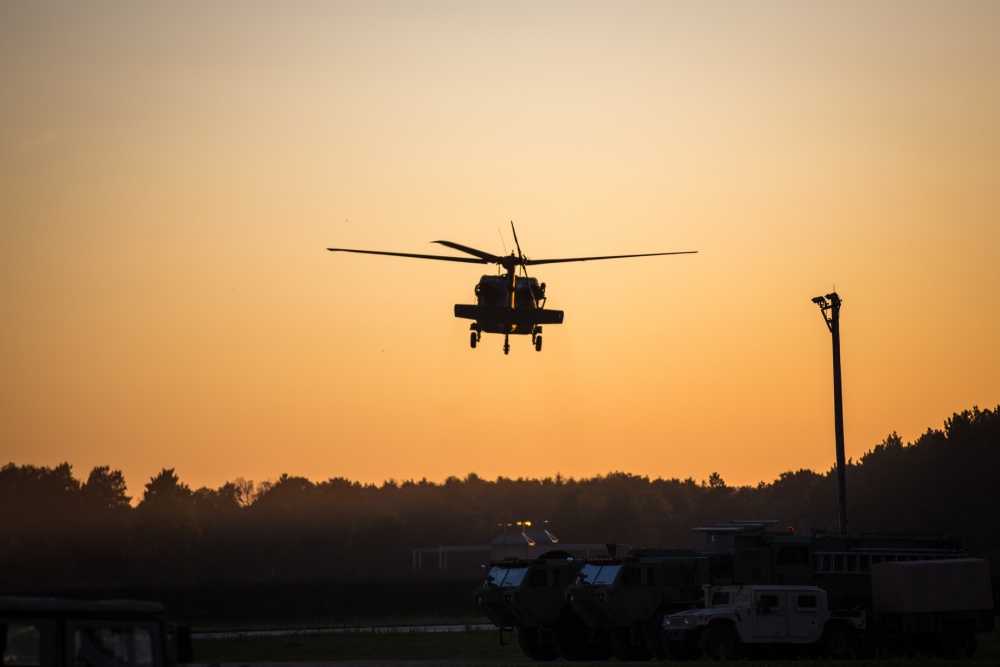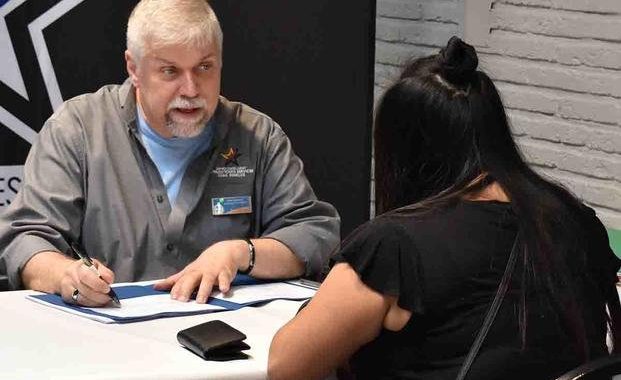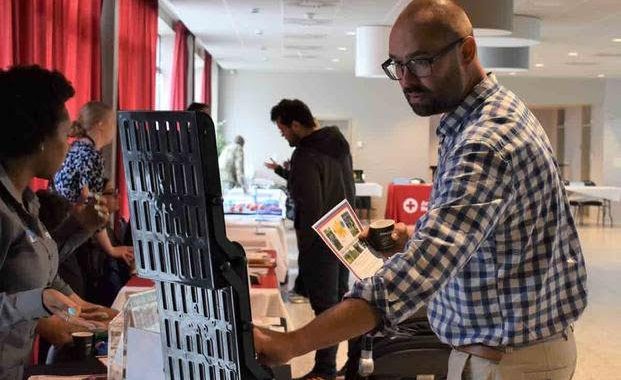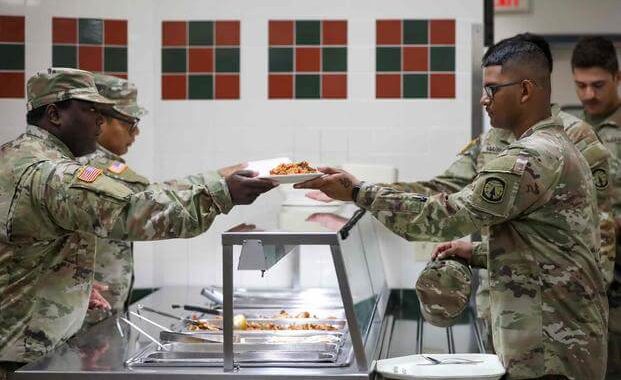Army Reserve Premier Exercise, CSTX, Continues To Evolve During Fort McCoy Training
8 min read
FORT MCCOY, WI, UNITED STATES
Courtesy Story
Fort McCoy Public Affairs Office
BY SGT. 1ST CLASS DEBRALEE BEST
86th Training Division
The Combat Support Training Exercise (CSTX) hosted by the 86th Training Division (TD) at Fort McCoy has undergone an evolution in recent years, but most of those changes have taken place in the past two years.
This year’s two exercises in July and August were evidence of those changes.
These changes are designed to change an Army Reserve Soldier’s training to resemble a peer-to-near-peer competitor battlefield instead of an insurgent battlefield. The previous model of training focused on an established area of operations or a forward-operating base as well as stability operations including nation building, infrastructure improvement, and defending themselves against small team of insurgents and improvised explosive devices. This focus has shifted in the past two years with the use of tactical assembly areas (TAA), allowing more staging and moving forward into kinetic operations.
“Instead, units have to come out here like its brand new property, brand new land, brand new battlefield space. They have to be tactically sound in their movement; they have to practice the fieldcraft of occupying an assembly area, defending themselves, (and) being able to establish communication with their higher headquarters and adjacent units and subordinate units; and then (they) ultimately be able to perform those collective tasks in which their specific units would be assigned,” said Col. Richard Smested, deputy commander, 86th TD.
Each military occupational specialty begins its collective tasks as at any other CSTX, but with the idea that the threat is real.
“All (Soldiers operate) under the idea that at any given time they may have to defend themselves in an environment where they don’t know exactly where the enemy is or how active — or as we say, kinetic. The battlefield may actually be in the next one to 24 hours,” Smested said.
Austerity is another measure the 86th TD uses to shift the ideas of battlefield operations.
“I think you notice (austerity) because we force it. You give them locations that aren’t so spacious, in a sense, and you make them get into the woods and the weeds a little bit,” said Command Sgt. Maj. Doug Dieckman, senior enlisted adviser, 86th TD.
The 86th TD also uses austere operations to work with units to expand their planning skills.
“We as an Army are weak in our fieldcraft, and in order to bring our rotational training units into a position of being better at fieldcraft, we had to start with the planning process, enabling them in being more engaged in planning their movement to an austere environment and owning it,” said Col. Tamara Ardent, chief of staff, 86th TD. “The change with CSTX is that we used to do a lot more of the planning and dictate this is where you’re going in the field. Now, in the planning process, we give them an area of operations, and they analyze the terrain and identify where they best would be suited to set up their tactical posture in the field environment.”
But, Dieckman also said forcing that change — while increasing the tactical advantage — is not all that needs to be done.
“People are understanding what austere means more and how (to) take advantage of where I’m at to provide some cover and concealment so I don’t have to create it. So, taking advantage of their surroundings, I think that’s better,” said Dieckman. “The message about being austere and the where part of it, kind of what it looks like, I think is more clear, but now it’s developing security, getting your communications established and going from there.”
The 86th TD also works into the scenario a time for units to “jump TOC” (tactical operations center) or move their entire operation to another location on the battlefield. This is another opportunity for Soldiers to learn to move and conceal themselves better.
“Iteration two when we jumped people, … the TAAs looked much better, much more concealed. They’ve got concertina wire set up (and) they’re fortifying their area, so having them jump their TOC and occupy a new TAA is huge for learning, and it gives them an opportunity to make corrections on their deficiencies and educate their Soldiers on what it actually means,” Dieckman said.
All of these changes work together with another transition — a linear battlefield.
“One of the things that’s also a little different is we’ve returned to what we used to call more of a linear battlefield where we have a clear identification of where the forward edge of the battlefield is. … We have brigade combat teams that are notional in front of our units who are at this exercise, and this exercise is really occupying a core support area and understanding that we’ve got combat forces in front of us who are engaged in a more force-on-force type of battle,” Smestad said. “Which is different than what we did in the past. That was more of an asymmetrical warfare where we could have enemy forces or insurgent forces anywhere on the battlefield, and there was no such thing as the front edge of the battle or a forward part of the battlespace. We’re trying to get back to more of what we would have called the more traditional land warfare.”
The changes to the battlefield continue to evolve, but there have also been other changes to operations. One of these was the inclusion of a senior trainer, which began two years ago.
The senior trainer is part of the training unit’s chain of command and therefore has more authority and pull with the unit, Arendt said.
“The inclusion of the senior trainer … has had significant benefit in that the senior trainer is really looking at the defensive posture and doing the coaching and mentoring from that chain of command from the rotational training units so that has also had an impact on their proficiencies as they go through the exercise in respect to austerity,” she said.
This inclusion allows the 86th TD to focus on the exercise as a whole and not individual Soldiers.
“The senior trainer has provided a solid avenue of mentoring and coaching that the platform really did not have the ability to do,” said Arendt. “It allows us, the 86th to really focus on providing a quality exercise, a smooth running operation.”
Another change integrated into the platform is an expanded supply chain. In 2018, CSTX had a satellite location at Camp Ripley, Minn., that units at Fort McCoy were tasked to supply. This year a fuel operation was included called Northern Strike.
“Even in the planning process, … everyone has a more challenging experience to develop a plan to support that type of operation,” Arendt said. “Not only for (those of) us planning the platform is it more difficult, but for all the units in the exercise that have to be integrated, it’s more difficult because there’s a distance that they’re not used to, and there is the reality that things need to be pushed in order for people to have what they need on the other end. That makes it truly real.”
Supplying a unit from a distance, like Camp Ripley, trains for real-world issues that units have to work to fix.
“It taught everyone to do their job better because we had live complaints and live problems,” said Arendt. “It’s not just a quick fix because you can’t just bop over to the next TAA on Fort McCoy and fix it. … What I’m trying to say, in a nutshell, is it stressed the supply chain, and it stressed all of the units’ understanding of the importance of all of their systems. It’s really the only place I think in the United States Army where we can test an extended supply chain operation.”
The Northern Strike mission not only provided real-world delivery of fuel to Michigan but also allowed the Soldiers to experience a mission beyond the confines of Fort McCoy, giving them more robust and realistic training. It also provided training to establish trailer transfer points and still be provided engagements from opposing forces.
“If you think about the distance, that was a true training mission for our transportation units,” Arendt said. “They were literally in civilian traffic hauling a commodity, and it was a distance. Again, the transportation company here going 5 miles on Fort McCoy is different than going 100 miles, 200 miles through tolls. It’s good training.”
For the August CSTX, the 86th TD developed a proof of principle for a 21-day noncontiguous exercise. The boots-on-ground time was cut to 15 days, but commanders were given an additional six days to complete training they felt they needed.
“It is going to be much more compressed, so the efficiency and the effectiveness of our training time really needs to be ramped up and used to the benefit of the Soldier, even more so,” Smestad said.
Main reasons for this change are to reduce strain on employers and to provide Soldiers more concentrated training.
“Twenty-one days is a long time, and it’s a stress on Reserve Soldiers at large. It’s a 21-day exercise when really their employers are committed to 14 days. Obviously our Reserve Soldiers step to the plate many places, but the strain on us alone on providing a 21-day exercise means we’re here early and stay late. It’s just a strain,” Arendt said. “Secondly, I think if done right, … the condensed exercise (will) be able to create a more intense scenario.”
Units will lose two days on arrival and departure times for the exercise as well as two days on the field training exercise. This means they will have less time to prepare to enter the field and less time to pack upon leaving the field.
The removal of those six days will really ramp up the units’ timelines and, Arendt said, create more proficiency where the Army needs to improve.
“One would like to think the 15-day exercise would give a more intense environment for units to actually come in, move to the field, … establish their operations, move their operations and then move again to redeploy that they’re going to learn more about what I think is a key lost art: Mobility for the core support area,” Arendt said.
“We need to be a mobile force. If we were ever to face a near-peer competitor, it will be a moving battlefield, and the core support area needs to train for intensity and movement,” she said.
“Units have to get more proficient at establishing their operations quickly, getting their job done, tearing it down quickly and moving. That’s what I hope we see in a 15 day (exercise), an increased intensity that actually gets us closer to what we need to be training for.”








